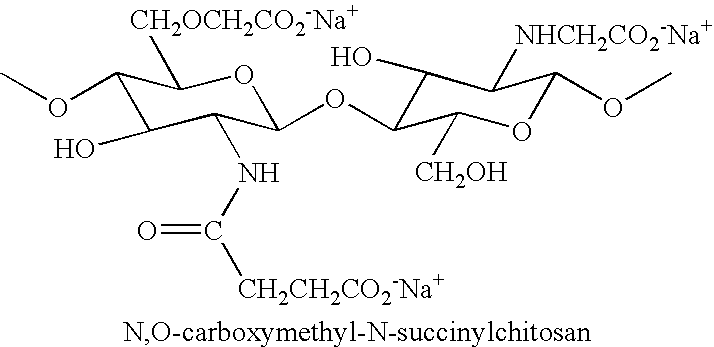N-acylated chitinous polymers and methods of use thereof
a technology of n-acylated chitinous polymers and polymers, which is applied in the direction of peptides, drug compositions, metabolic disorders, etc., can solve the problems of undesirable insolubility of nocc, nocc precipitation, and limited use of chitin and chitosan, and achieve the effect of expanding the solubility rang
- Summary
- Abstract
- Description
- Claims
- Application Information
AI Technical Summary
Benefits of technology
Problems solved by technology
Method used
Image
Examples
example 1
Synthesis of N,O-Carboxymethyl-N-Succinylchitosan (NS—NOCC)
[0099]This example describes the synthesis of a polymer of the invention, N,O-carboxymethyl-N-succinylchitosan, from NOCC.
[0100]15 kilograms of water solution containing 150 grams of a high viscosity NOCC was stirred as 105 grams of succinic anhydride was added over 30 minutes at room temperature. The pH was maintained between 7-9. The reaction was allowed to proceed for 2.5 hours. The mixture was added to 40 liters of anhydrous isopropanol and the resulting precipitate was collected by filtration. The product was washed 3 times in 80% methanol / water and then air-dried. The yield was 186 grams.
[0101]The product was a white, totally soluble solid with a viscosity of 900 cps for a 1% solution (Brookfield, spindle #4, 20C) and having an ash of 23.4%. The degree of carboxylation was 1.3.
example 2
Alternate Synthesis of N,O-Carboxymethyl-N-Succinylchitosan (NS—NOCC)
[0102]This example describes an alternate method for the synthesis of a polymer of the invention, N,O-carboxymethyl-N-succinylchitosan, in this case from chitosan.
N-Succinylation of Chitosan
[0103]11.0 grams of high viscosity chitosan was added to 1 liter of 0. 12% hydrochloric acid and stirred for 1.75 hours. The pH was adjusted to 4. 17.5 grams of solid succinic anhydride was added over 40 minutes while the pH was maintained at 5-6 by addition of dilute sodium hydroxide. The mixture was stirred for 3.5 hours. The final pH was 6.
[0104]The solution was then transferred to dialysis sacks and soaked for 4 days with frequent changes of water. The contents of the dialysis sacks were then filtered through 120 micron screening. The product was then precipitated and washed in isopropanol and then air dried. The yield of N-succinylchitosan was 6.2 grams with a degree of succinylation of 0.9 and a residue upon ignition of 9....
example 3
Heterogeneous Succinylation of Chitosan
[0106]This example describes an alternate method to succinylate chitosan.
[0107]A slurry of 33 grams of high viscosity chitosan in 3 kilograms of water was prepared and stirred. 54 grams of succinic anhydride was added over 50 minutes and the pH of the mixture was maintained between 7 and 9 by the addition of 10M sodium hydroxide. The mixture was stirred for a further 4 hours. The chitinous material was partially dissolved. The product was precipitated by adding the mixture to 7 liters of isopropanol. The voluminous product was then washed with 80% methanol / water and air dried. The yield of the product was 46 grams. The resulting product was a viscous, lubricious solution in water and insoluble in 1% acetic acid. The solutions of the product did not form firm gels after the addition of glyoxal. The degree of carboxylation was determined to be 0.7.
PUM
| Property | Measurement | Unit |
|---|---|---|
| molecular weight | aaaaa | aaaaa |
| molecular weight | aaaaa | aaaaa |
| molecular weight | aaaaa | aaaaa |
Abstract
Description
Claims
Application Information
 Login to View More
Login to View More - R&D
- Intellectual Property
- Life Sciences
- Materials
- Tech Scout
- Unparalleled Data Quality
- Higher Quality Content
- 60% Fewer Hallucinations
Browse by: Latest US Patents, China's latest patents, Technical Efficacy Thesaurus, Application Domain, Technology Topic, Popular Technical Reports.
© 2025 PatSnap. All rights reserved.Legal|Privacy policy|Modern Slavery Act Transparency Statement|Sitemap|About US| Contact US: help@patsnap.com



